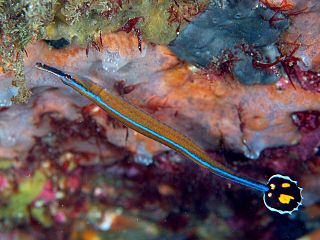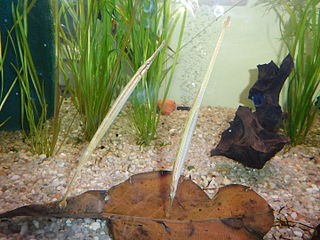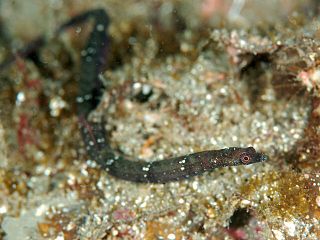
The Syngnathidae is a family of fish which includes seahorses, pipefishes, and seadragons. The name is derived from Ancient Greek: σύν, meaning "together", and γνάθος, meaning "jaw". The fused jaw is one of the traits that the entire family have in common.

Pipefishes or pipe-fishes (Syngnathinae) are a subfamily of small fishes, which, together with the seahorses and seadragons, form the family Syngnathidae.

Syngnathus is a genus of fish in the family Syngnathidae found in marine, brackish and sometimes fresh waters of the Atlantic, Indian and Pacific Ocean. Fossils of these species are found from the Oligocene to the Pleistocene. They are known from various localities of Greece, Italy, Germany and United States.

Stigmatopora is a genus of pipefishes native to the Indian and Pacific Oceans.

Doryrhamphus and Dunckerocampus, popularly known as flagtail pipefish, are two genera of fishes in the family Syngnathidae. They are found in warm, relatively shallow waters of the Indo-Pacific, with a single species, D. paulus, in the eastern Pacific. Most of these pipefishes are very colourful, and are fairly popular in the marine aquarium hobby despite requiring special care and not being recommended for beginners.

Microphis is a genus of pipefishes within the family Syngnathidae. Members of this genus are notable among the Syngnathidae for residing in mainly fresh and brackish waters. Adults breed in coastal rivers, streams, or lakes, and fertilized eggs are carried by the male pipefish in a brood pouch extending along his entire ventral surface.

Corythoichthys is a genus of pipefishes of the family Syngnathidae. All species in the genus are found in the tropical Indian and Pacific Oceans on reefs or rubble bottoms. Relationships and taxonomy within the genus are still in debate, but there may be at least 23 species.

Dunckerocampus is a genus of pipefishes one of two genera known as the flagtail pipefishes. This genus is native to the Indian and Pacific Oceans where they are usually found in reef environments. These species are elongated and have a maximum length between 10 and 20 centimetres, with D. chapmani being the only species with a maximum length below 15 centimetres (5.9 in). Their tail is red with a whitish edge, and in some species there is a white or yellow spot in the center. All except D. baldwini have vertical red/brown and yellow/white stripes on their body.

Doryrhamphus is a genus of pipefishes, one of the two genera colloquially known as flagtail pipefishes and are popular in the aquarium trade. The members of this genus are native to the Indian and Pacific Oceans where they inhabit reef environments. The species in this genus have a maximum length of 14 centimetres (5.5 in) or less, with D. janssi being the only species that surpasses 8.5 centimetres (3.3 in). Most species have a horizontal blue line along their body, and all have a whitish-edged tail that is marked contrastingly with black, red or yellow.

Halicampus is a genus of pipefishes of the family Syngnathidae, containing 12 described species.

Siokunichthys is a genus of pipefishes native to the Indian and Pacific Oceans. One species, Siokunichthys nigrolineatus, has a commensal relationship with mushroom corals of the genus Fungia.
Choeroichthys is a genus of pipefishes of the family Syngnathidae native to the Indian and Pacific Oceans.

Bulbonaricus is a genus of pipefishes native to the Indian and Pacific Oceans.

Cosmocampus is a genus of pipefishes.
The upside-down pipefish is a species of pipefish endemic to the coast of southern Australia, from New South Wales to Geographe Bay in Western Australia, where it is found in rocky reefs at depths of from 2 to 15 metres. It grows to a length of 9.2 centimetres (3.6 in) SL. This species is the only known member of its genus. Like other pipefish it is ovoviviparous but it may breed seasonally, as gravid males have been collected between September and November.
Micrognathus is a genus of pipefishes, with these currently recognized species:
Bryx analicarens is a species of marine fish of the family Syngnathidae. It is found in rocky tidepools and algae to depths of 45 metres (148 ft), in the Indian Ocean, Red Sea, and Persian Gulf. It can grow to lengths of 13 centimetres (5.1 in), and is suspected to feed on benthic and planktonic crustaceans. This species is ovoviviparous, with the males carrying eggs in a brood pouch until they hatch.
Bryx dunckeri is a species of pipefish of the family Syngnathidae. It is found in the western Atlantic Ocean, from North Carolina to Florida and the Bahamas, in the Gulf of Mexico, and off South America to Macau, Brazil. It inhabits shallow waters above algae and rock, both in estuaries and seagrass beds. It primarily feeds on benthic invertebrates such as crabs and molluscs, and can grow to lengths of 10 centimetres (3.9 in). This species is ovoviviparous, with the males carrying eggs until they are ready to hatch.
Bryx randalli, the ocellated pipefish, is a species of marine fish of the family Syngnathidae. It is found in the western Atlantic in the Caribbean Sea, where it inhabits the shallow subtidal zone to depths of 30m. It feeds on benthic invertebrates such as crabs and molluscs, and is less than 10 cm long. This species is ovoviviparous, with the males carrying the eggs in their brood pouch until they hatch.
Bryx veleronis is a species of marine fish of the family Syngnathidae. It is found in the Eastern Pacific, off the coasts of Mexico, Costa Rica, Panama, Malpelo Island (Colombia), and the Galápagos Islands (Ecuador). There is very little known about this species, but it is thought to inhabit depth ranges of roughly 30-40m, grow to lengths of 6 cm, and consume small crustaceans. It is ovoviviparous, with males carrying eggs in a brood pouch until they hatch.










